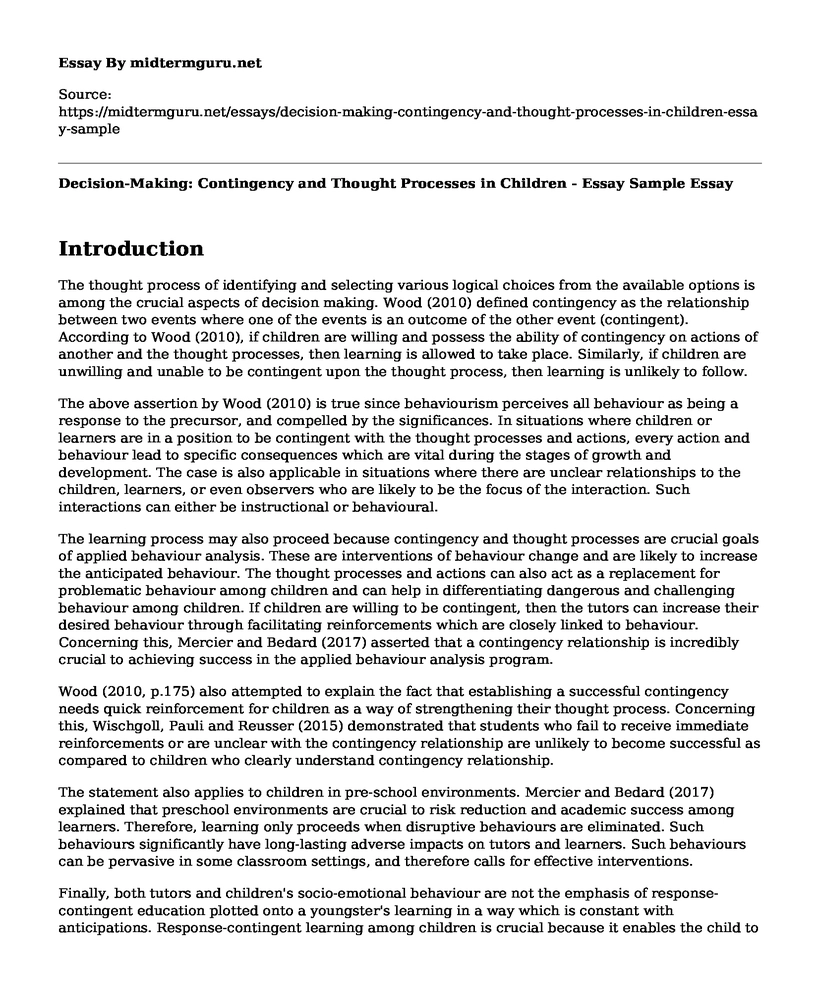Introduction
The thought process of identifying and selecting various logical choices from the available options is among the crucial aspects of decision making. Wood (2010) defined contingency as the relationship between two events where one of the events is an outcome of the other event (contingent). According to Wood (2010), if children are willing and possess the ability of contingency on actions of another and the thought processes, then learning is allowed to take place. Similarly, if children are unwilling and unable to be contingent upon the thought process, then learning is unlikely to follow.
The above assertion by Wood (2010) is true since behaviourism perceives all behaviour as being a response to the precursor, and compelled by the significances. In situations where children or learners are in a position to be contingent with the thought processes and actions, every action and behaviour lead to specific consequences which are vital during the stages of growth and development. The case is also applicable in situations where there are unclear relationships to the children, learners, or even observers who are likely to be the focus of the interaction. Such interactions can either be instructional or behavioural.
The learning process may also proceed because contingency and thought processes are crucial goals of applied behaviour analysis. These are interventions of behaviour change and are likely to increase the anticipated behaviour. The thought processes and actions can also act as a replacement for problematic behaviour among children and can help in differentiating dangerous and challenging behaviour among children. If children are willing to be contingent, then the tutors can increase their desired behaviour through facilitating reinforcements which are closely linked to behaviour. Concerning this, Mercier and Bedard (2017) asserted that a contingency relationship is incredibly crucial to achieving success in the applied behaviour analysis program.
Wood (2010, p.175) also attempted to explain the fact that establishing a successful contingency needs quick reinforcement for children as a way of strengthening their thought process. Concerning this, Wischgoll, Pauli and Reusser (2015) demonstrated that students who fail to receive immediate reinforcements or are unclear with the contingency relationship are unlikely to become successful as compared to children who clearly understand contingency relationship.
The statement also applies to children in pre-school environments. Mercier and Bedard (2017) explained that preschool environments are crucial to risk reduction and academic success among learners. Therefore, learning only proceeds when disruptive behaviours are eliminated. Such behaviours significantly have long-lasting adverse impacts on tutors and learners. Such behaviours can be pervasive in some classroom settings, and therefore calls for effective interventions.
Finally, both tutors and children's socio-emotional behaviour are not the emphasis of response-contingent education plotted onto a youngster's learning in a way which is constant with anticipations. Response-contingent learning among children is crucial because it enables the child to recognize his or her hidden abilities (contingency recognition and cognizance). These accompany the child's enjoyment and pleasure during the crucial stages of growth. Therefore, caregivers who provide child learning opportunities which lead to augmented child competency, which is a consequent gratification from the child and their determinations. As a result, warranty socio-emotional behaviour, which is linked to response-contingent child conduct, is an indicator of the value-added profits of the contingency education prospects for the tutors and the child (Wischgoll et al., 2015).
References
Mercier, J. and Bedard, M., 2017. An educational neuroscience perspective on tutoring: To what extent can electrophysiological measures improve the contingency of tutor scaffolding and feedback?. Themes in Science and Technology Education, 9(2), pp.109-125.
Wischgoll, A., Pauli, C. and Reusser, K., 2015. Scaffolding-How can contingency lead to successful learning when dealing with errors?. ZDM, 47(7), pp.1147-1159.
Wood, D., 2010. How Children Think and Learn, eTextbook. John Wiley & Sons.
Cite this page
Decision-Making: Contingency and Thought Processes in Children - Essay Sample. (2023, Jan 14). Retrieved from https://midtermguru.com/essays/decision-making-contingency-and-thought-processes-in-children-essay-sample
If you are the original author of this essay and no longer wish to have it published on the midtermguru.com website, please click below to request its removal:
- The Disability Matrix in Schools
- Paper Example on Products and Services Offered by Coca-Cola
- Intrinsic Aspects of the Language - Essay Sample
- Critical Analysis of an Online Article on Child Development
- Articles Analysis Essay on Transformational Leadership
- Paper Example on Drugs And Substance Abuse Among Students
- Depression: A Combination of Psychological, Social and Biological Factors - Essay Sample







